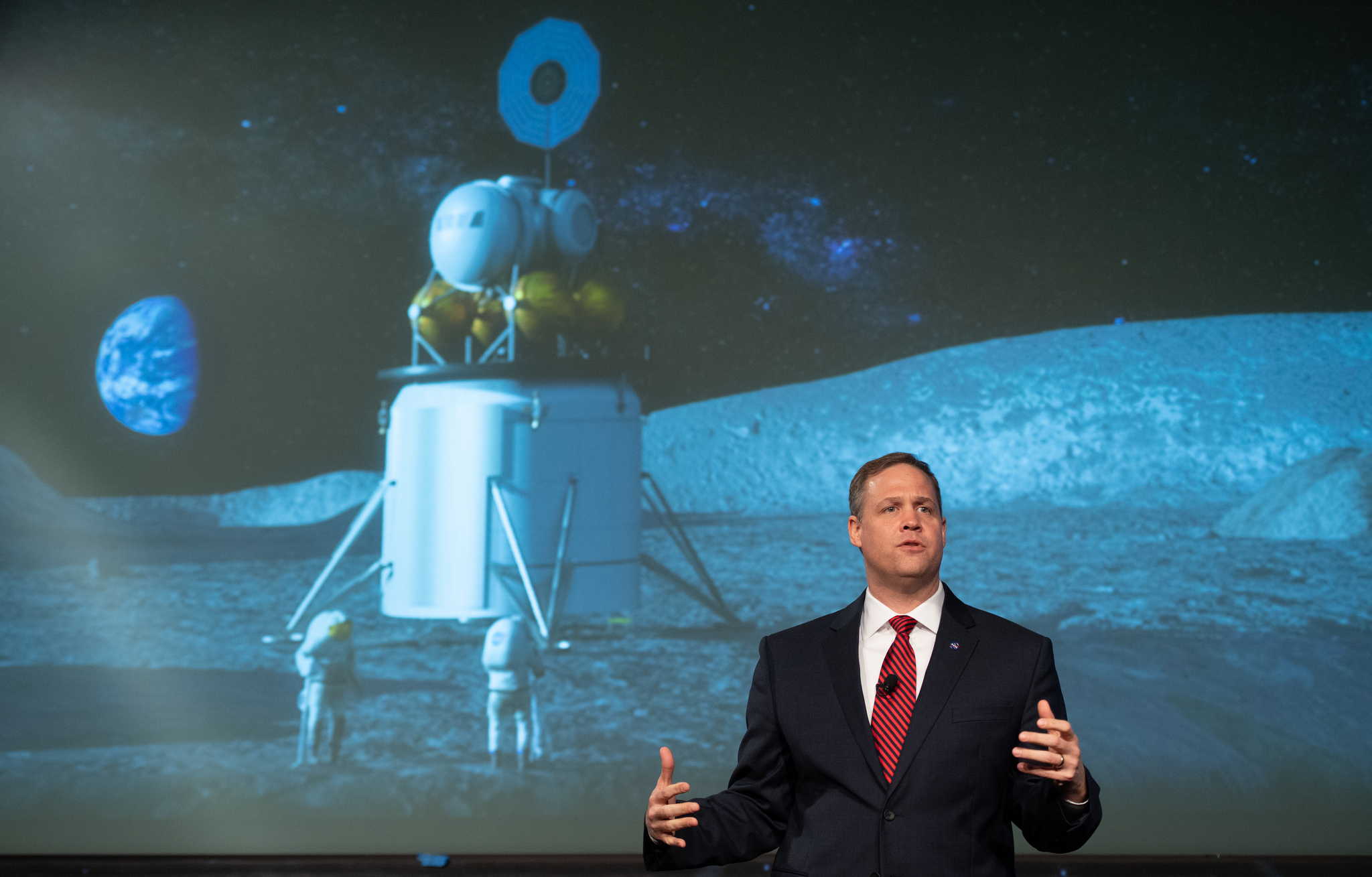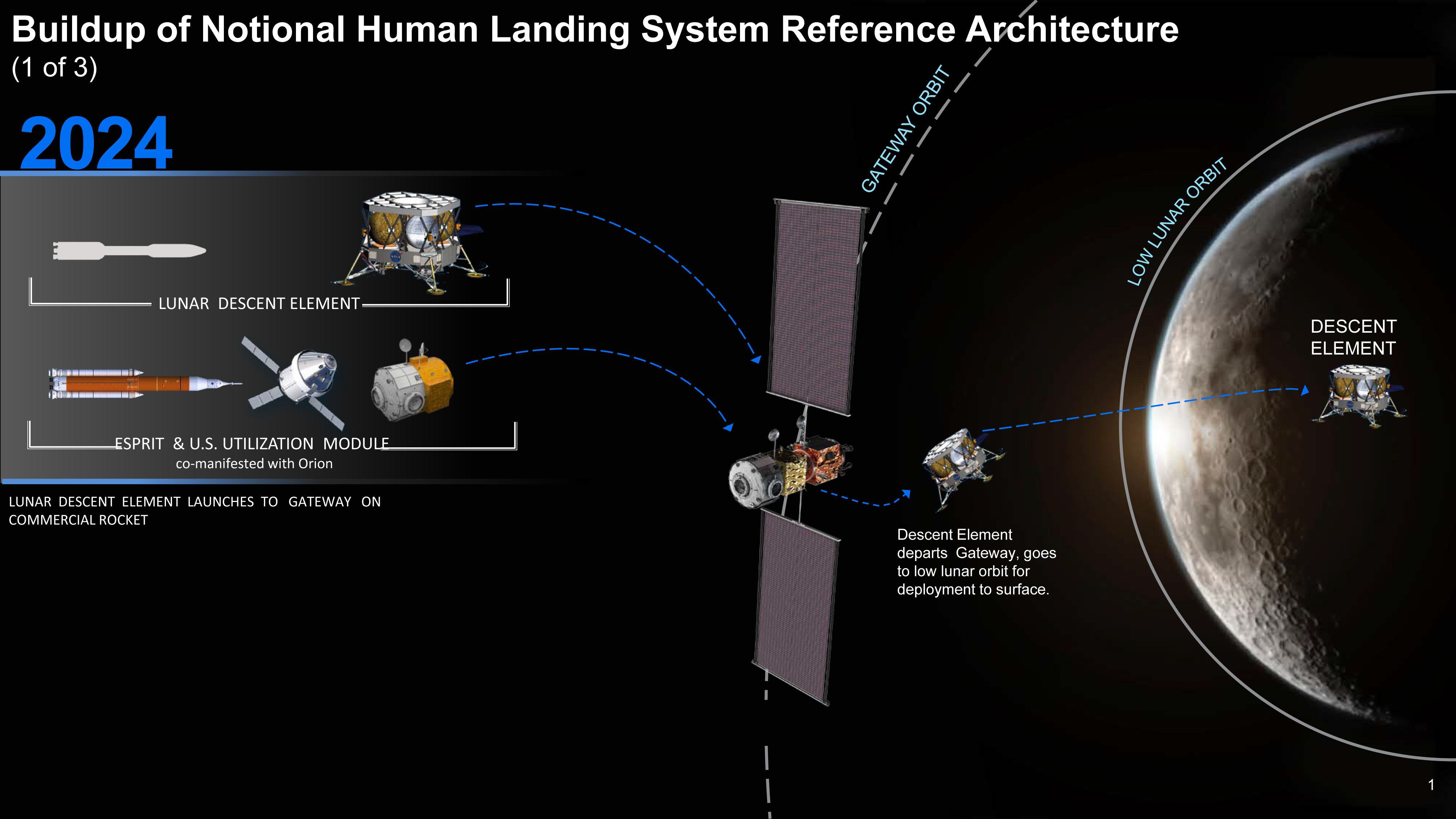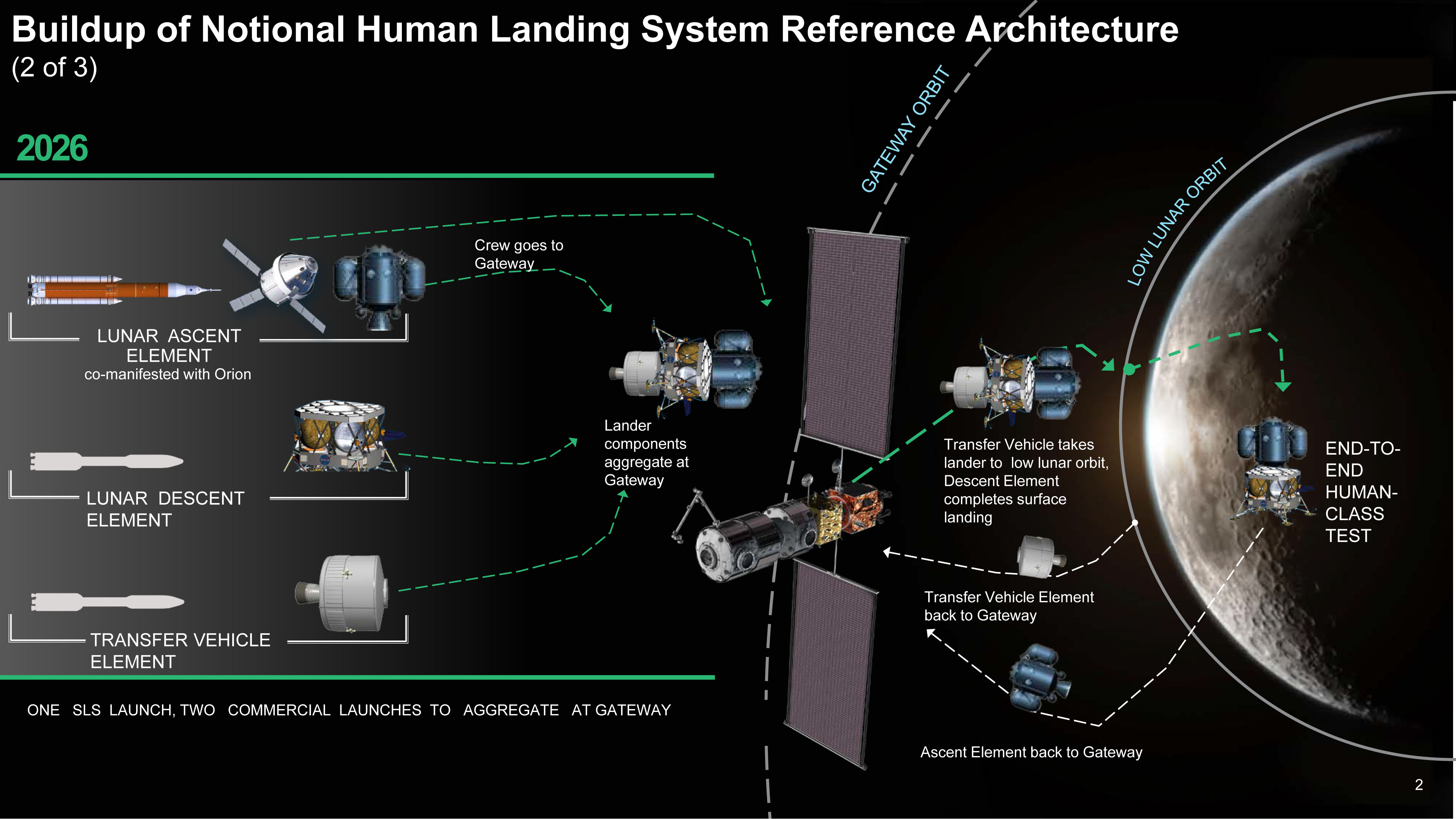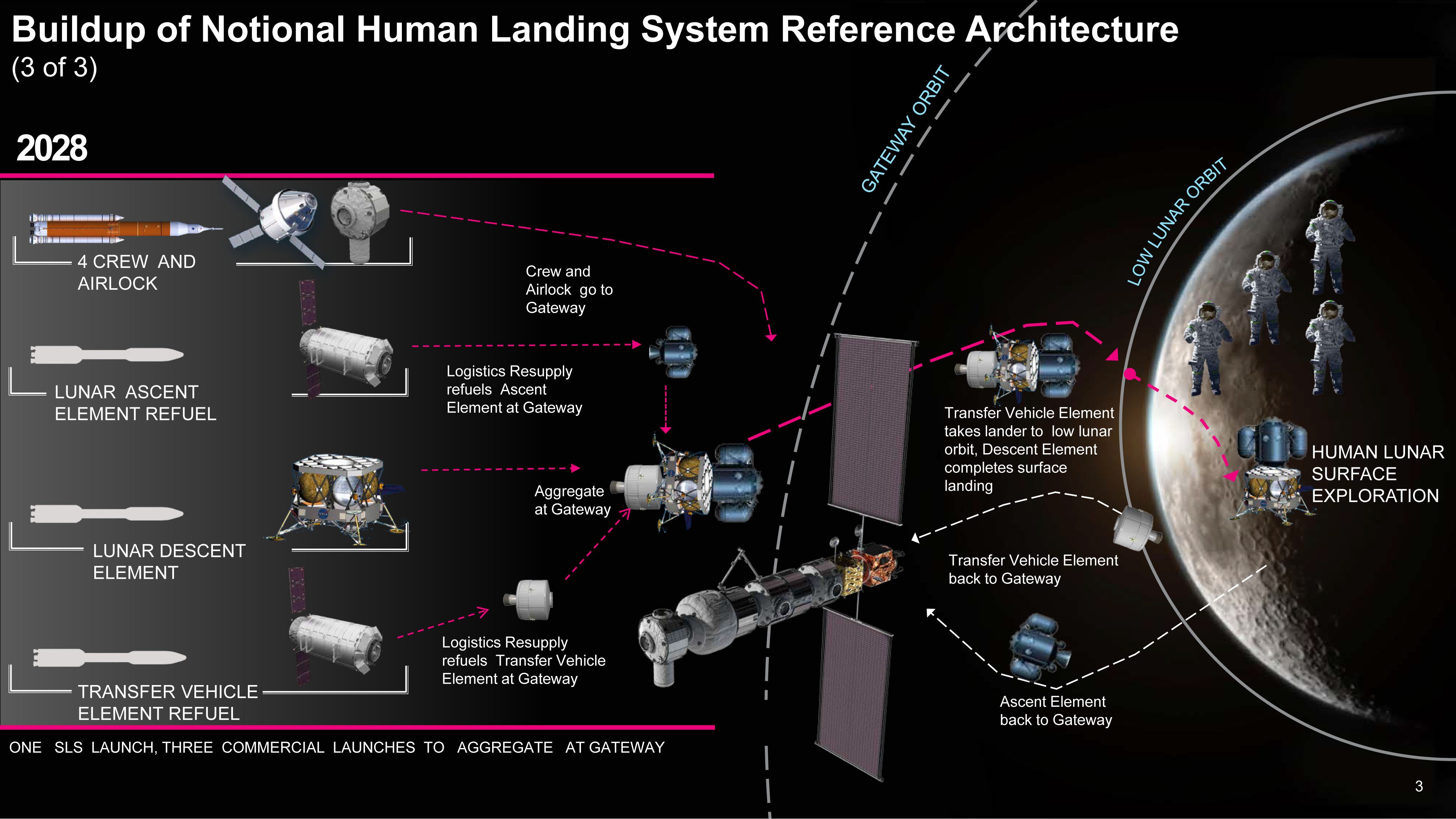This Is NASA's Plan to Land Astronauts on the Moon in 2028 with Commercial Vehicles
NASA wants ideas for moon landers, space tugs and refueling ships.

WASHINGTON — NASA really wants to land astronauts on the moon in 2028. But to do that, the agency is looking to commercial space companies to build the landers, space tugs and refueling stations required to make a moon exploration effort that lasts.
"This time, when we go to the moon we're going to stay," NASA Administrator Jim Bridenstine told a roomful of space industry representatives here Thursday (Feb. 14). "So, we're not going back to the moon to leave flags and footprints and then not go back for another 50 years. We're going to go sustainably. To stay. With landers and robots and rovers — and humans."
The gathering at NASA's headquarters comes a week after the agency unveiled what it calls a Broad Agency Announcement calling on commercial space companies to submit ideas for lunar landers, tug-like transfer vehicles and refueling systems to gas up those vehicles for reuse. Interested companies have until March 25 to submit their ideas, with NASA aiming to make selections in May and issue contracts of up to $9 million for follow-up studies in July (just in time for the 50th anniversary of the Apollo 11 moon landing).
"This is going to be fast," said William Gerstenmaier, NASA's associate administrator of the Human Exploration and Operations. "We're going to need the best and brightest from you in industry. We're going to need the best and brightest from the international partner community to pull all this off."
NASA's renewed push to the moon comes from Space Policy Directive 1, an order signed by President Donald Trump in December 2018 directing NASA to return astronauts to the moon in a sustainable way.
The 21st century lunar architecture will use NASA's planned Gateway, an orbital space station near the moon, as a way station for astronauts en route to the moon. Transfer vehicles at the Gateway will ferry lunar landers to and from low lunar orbit. The landers (which consist of a descent element and reusable ascent element that carries the crew) would then make the final trip to the lunar surface.
Refueling spacecraft based at the Gateway will then resupply the transfer tugs and returning ascent vehicles for return trips to the moon. NASA leaders described it as an "open architecture" designed to foster new capabilities to explore the moon.
Get the Space.com Newsletter
Breaking space news, the latest updates on rocket launches, skywatching events and more!
"We're doing it in a way that we've never done before," Bridenstine told reporters before the industry presentation.

NASA's Moon Return Plan: 2024
The first phase of NASA's return to the moon with astronauts begins in 2024 with an uncrewed decent vehicle landing test as the agency builds up its Gateway station in cis-lunar space. The descent vehicle, at this stage, is not reusable.

2026: Uncrewed Lunar Lander Full Test
In 2026, NASA envisions a full-up uncrewed lunar landing on the moon. The test would use a tug-like transfer vehicle to move to low lunar orbit from NASA's Gateway station, then land. The lander's ascent element would return to orbit and be ferried back to the Gateway by the tug.

2028: Astronauts Back On the Moon
In 2028, NASA will send four astronauts to the moon for a lunar landing from the agency's Gateway station, supported by refueling spacecraft. The lunar ascent and transfer vehicles will be reusable. Astronauts would stay on the moon for up to a week at a time.
NASA envisions having multiple providers for lunar vehicles, Bridenstine said, similar to how two companies (SpaceX and Northrop Grumman) fly cargo missions to the International Space Station for the agency today. SpaceX and Boeing, in another example, expect to begin flying astronauts to and from the station for NASA later this year.
"We want many different participants, both commercially and internationally," Bridenstine said. "The purpose of the open architecture is to enable us to get to more parts of the moon than we've ever been able to get to before."
There are three main phases for NASA's return to the moon. Here's how it works:
First, in 2024, the space agency aims to launch the Orion spacecraft and European Service Module to the Gateway on the Space Launch System, NASA's new megarocket. A lander descent module will then launch to the Gateway on a commercial rocket for an uncrewed test landing demonstration on the lunar surface.
In 2026, an Orion spacecraft will launch astronauts to the Gateway along with the ascent element of a crewed lunar lander. Two commercial rockets will then launch a transfer vehicle and descent element of the lander to the Gateway. The transfer vehicle will fly the combined lunar lander from the Gateway to low-lunar orbit, then detach so the lander can descend to the moon's surface in an uncrewed full-up landing test. The transfer vehicle and lunar ascent element then return to the Gateway.
In 2028, the entire system comes together. A crew of four astronauts will launch to the Gateway in an Orion spacecraft on a Space Launch System rocket. They'll deliver an airlock to the station while they're at it. A series of commercial launches then follow, including two cargo and refueling missions (one for the Gateway and one for the transfer vehicle and lunar ascent element), and a new lunar descent element.
The astronauts will then use the transfer vehicle to fly their lander into low lunar orbit, detach and make the trip to the lunar surface. If this NASA plan is realized, the space agency could have humans back on the moon about one year before the 60th anniversary of the Apollo 11 landing.
One other takeaway from NASA's pitch on Thursday: The space agency doesn't just have its sights set on the moon.
"We're going to take as much of this as possible and the replicate it at Mars," Bridenstine said.
And while NASA is pushing forward on plans to return astronauts to the moon, the space agency is also forging ahead on its lunar science program.
Next week, the space agency will announce 12 science payloads it is developing for future flights to the moon under its Commercial Lunar Payload Services program, Thomas Zurbuchen, NASA's associate administrator for science missions, told reporters here. Those payloads will need rides to the moon, possibly as early as this year, and NASA is relying on commercial launch providers to step up to the plate.
"We care about speed," Zurbuchen said. "We want to start taking shots on goal."
Email Tariq Malik at tmalik@space.com or follow him @tariqjmalik. Follow us @Spacedotcom and Facebook.
Join our Space Forums to keep talking space on the latest missions, night sky and more! And if you have a news tip, correction or comment, let us know at: community@space.com.

Tariq is the Editor-in-Chief of Space.com and joined the team in 2001, first as an intern and staff writer, and later as an editor. He covers human spaceflight, exploration and space science, as well as skywatching and entertainment. He became Space.com's Managing Editor in 2009 and Editor-in-Chief in 2019. Before joining Space.com, Tariq was a staff reporter for The Los Angeles Times covering education and city beats in La Habra, Fullerton and Huntington Beach. In October 2022, Tariq received the Harry Kolcum Award for excellence in space reporting from the National Space Club Florida Committee. He is also an Eagle Scout (yes, he has the Space Exploration merit badge) and went to Space Camp four times as a kid and a fifth time as an adult. He has journalism degrees from the University of Southern California and New York University. You can find Tariq at Space.com and as the co-host to the This Week In Space podcast with space historian Rod Pyle on the TWiT network. To see his latest project, you can follow Tariq on Twitter @tariqjmalik.









